Zoom
Trash

Game Programming Patterns. Model–view–controller. Model–view–controller (MVC) is a software pattern for implementing user interfaces.

It divides a given software application into three interconnected parts, so as to separate internal representations of information from the ways that information is presented to or accepted from the user.[1][2] The central component, the model, consists of application data, business rules, logic and functions. A view can be any output representation of information, such as a chart or a diagram. Multiple views of the same information are possible, such as a bar chart for management and a tabular view for accountants. The third part, the controller, accepts input and converts it to commands for the model or view.[3] Component interactions[edit] A typical collaboration of the MVC components In addition to dividing the application into three kinds of components, the Model–view–controller (MVC) design defines the interactions between them.[4]
Features - The Guerrilla Guide to Game Code. Introduction There are a lot of articles about games.
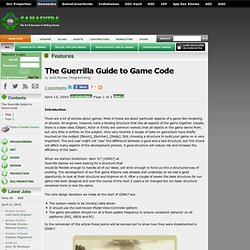
Most of these are about particular aspects of a game like rendering or physics. All engines, however, have a binding structure that ties all aspects of the game together. Usually there is a base class (Object, Actor or Entity are common names) that all objects in the game derive from, but very little is written on the subject. Only very recently a couple of talks on game|tech have briefly touched on the subject [Bloom], [Butcher], [Stelly]. When we started Shellshock: Nam ‘67 (SSN67) at Guerrilla Games we were looking for a structure that would be flexible enough to handle all of our ideas, yet strict enough to force us into a structured way of working. The core design decisions we made at the start of SSN67 are: In the remainder of this article these points will be worked out to show how they were implemented in SSN67.
Entities In SSN67 the base class for all game objects is called Entity. Logic vs Render, the separation of concerns « Aurelien Ribon's Dev Blog. On many occasions, I saw people wondering what magic they should cast at a physics engine to make it properly render its simulated objects on screen.
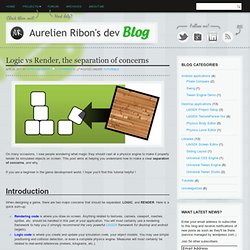
Book Title. Mini-kernel. MVC and graphics engines. Good use of the MVC pattern with Qt and Ogre for 3d editors. As many people, I want to do my first mini 3d editor for my game.
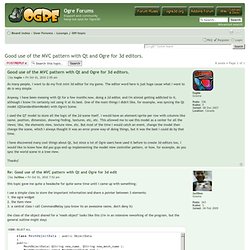
The editor word here is just huge cause what I want to do is very simple. Anyway, I have been messing with Qt for a few months now, doing a 2d editor, and I'm almost getting addicted to it, although I know I'm certainly not using it at its best. One of the main things I didn't like, for example, was syncing the Qt model (QStandardItemModel) with Ogre's Scene. I used the QT model to store all the logic of the 2d scene itself. Mixin. Mixins encourage code reuse and avoid well-known pathologies associated with multiple inheritance.[1] History[edit] Definition and implementation[edit] In Simula, classes are defined in a block in which attributes, methods and class initialization are all defined together; thus all the methods that can be invoked on a class are defined together, and the definition of the class is complete.
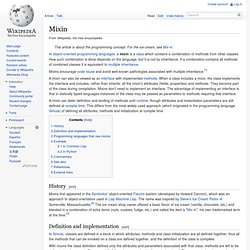
CLOS and Flavors allow mixin methods to add behavior to existing methods: :before and :after daemons, whoppers and wrappers in Flavors. CLOS added :around methods and the ability to call shadowed methods via CALL-NEXT-METHOD. An example is the + method combination, where the results of all applicable methods of a generic function are added to compute the return value. In an OOPSLA 90 paper,[4] Gilad Bracha and William Cook reinterpret different inheritance mechanisms found in Smalltalk, Beta and CLOS as special forms of a mixin inheritance. Mixins in game development. Programmers tend to think in the Object Oriented Programming paradigm all the time.
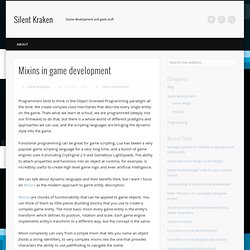
We create complex class hiercharies that describe every single entity on the game. Thats what we learn at school, we are programmed (deeply into our firmware) to do that, but there is a whole world of different pradigms and approaches we can use, and the scripting languages are bringing the dynamic style into the game. Functional programming can be great for game scripting, Lua has beeen a very popular game scripting language for a very long time, and a bunch of game engines uses it (including CryEngine 2.0 and Gamebryo LightSpeed). The ability to attach properties and functions into an object at runtime, for example, is incredibly useful to create high level game logic and even artificial intelligence. We can talk about dynamic languajes and their benefts here, but I want t focus on Mixins as the modern approach to game entity description:
Www.cs.umass.edu/~yannis/practical-fmtd.pdf. C++ Programming/Code/Design Patterns. Programming Patterns[edit] Software design patterns are abstractions that help structure system designs.
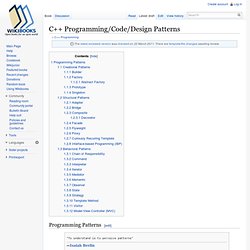
While not new, since the concept was already described by Christopher Alexander in its architectural theories, it only gathered some traction in programming due to the publication of Design Patterns: Elements of Reusable Object-Oriented Software book in October 1994 by Erich Gamma, Richard Helm, Ralph Johnson and John Vlissides, known as the Gang of Four (GoF), that identifies and describes 23 classic software design patterns. A design pattern is neither a static solution, nor is it an algorithm. A pattern is a way to describe and address by name (mostly a simplistic description of its goal), a repeatable solution or approach to a common design problem, that is, a common way to solve a generic problem (how generic or complex, depends on how restricted the target goal is).
Patterns can emerge on their own or by design. Each design pattern consists of the following parts: Forces Solution. Huston Design Patterns. C++ Design Pattern: What is a Design Pattern?